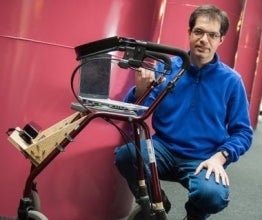Dr. Pascal Poupart helps to break the fall using smart walkers to help prevent injuries

“The walker is a double-edge sword. It’s supposed to help with stability, but if not used properly it can trigger falls and serious injuries,” says Poupart, an associate professor in the David R. Cheriton School of Computer Science.
Equipped with sensors and cameras
The walker is being developed with Eric Roy and Bill McIlroy, professors in the Faculty of Applied Health Sciences. It’s equipped with various sensors and cameras that gather large streams of data about how seniors use it. The intelligent walker will track and understand gait patterns and warn users or health care workers of any risks for falls.
“A lot of falls are due to people not using walkers properly. If we want to do better at keeping people stable, we need to understand how the person is using the walker,” he says.
The smart walker, equipped with a Microsoft Xbox 360 Kinect depth camera, helps track in 3D the older person’s leg movements and identify potential balance problems. Data is collected about speed, differences in load on each of the four wheels and acceleration patterns while the person uses it.
A tool for doctors and caregivers
Poupart has developed smart software to extract and interpret this data to automatically recognize user activities like walking forwards and backwards, sitting, standing and turning. His goal is to turn this into a tool that clinicians and caregivers can use to assess activity patterns of walker users and the situations in which they are most likely to fall.
Seniors with Alzheimer’s disease, for example, might lean back to sit on the walker and forget to lock the brakes, increasing the chances of a fall as the walker rolls away from them.
When people move into a retirement facility, this tool could help staff better assess how they use a walker and recommend adjustments to prevent falls, instead of waiting until after. The device could also monitor changes in residents’ walking abilities and if a person falls, its data recorder could be used like a black box after a plane crash to see what happened just before the accident.
Poupart also envisions a future model that will assist seniors living at home or in retirement communities with steering and braking. “Think of the walker as the smart phone for older people. It can help them to navigate more safely, but also give directions and remind them about appointments,” he says.